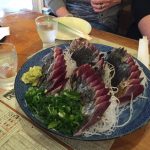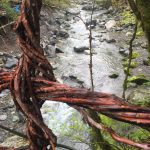Celebrating the Splendors of GeoEx’s Small-Group Journeys
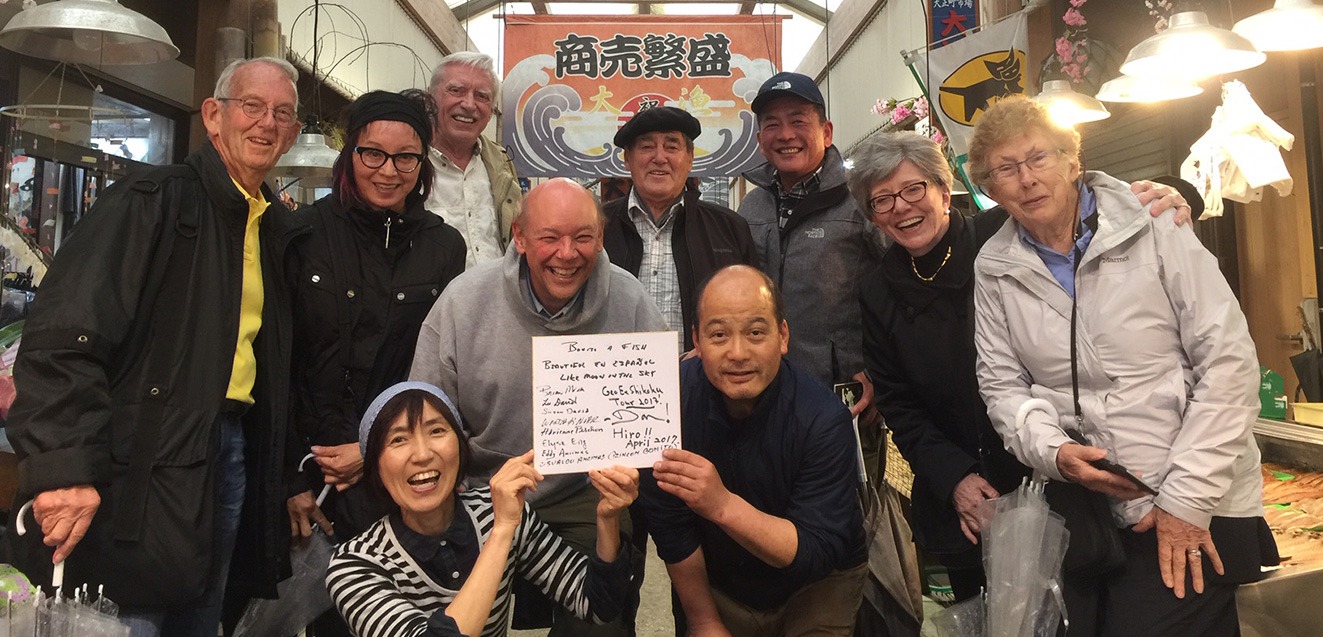
One of the many things that I love about leading trips for GeoEx is the company’s deep commitment to small-group travel. My Journey Through Ancient Japan is a perfect example. This journey is limited to eight travelers maximum. This small size cultivates a family-like camaraderie for the group, and enables a number of extraordinary experiences that a larger group simply couldn’t do. Here are three such experiences that I treasure from the trip.
Our journey begins in Kyoto, the former capital of Japan, where we explore some of the city’s most transporting temples, gardens, and neighborhoods. After two days in Kyoto, we venture to nearby Nara, the even more ancient capital of Japan, to pay our respects to the spectacular, 53-foot-tall bronze Buddha of Todaiji temple—and to enjoy an unforgettable tempura feast.
For this occasion, our wonderful host and chef, Nishinaka-san, reserves his one-counter, 12-seat tempura restaurant for just our group; in effect, it becomes our private temple of tempura. He greets us with a deep bow as we arrive, seats us at his counter, and pours a welcoming toast of plum liqueur.
Then he energetically sets to work right in front of us, choosing a fresh from-the-field vegetable or fresh-from-the-ocean delicacy that he has procured that morning. He expertly slices it, dips the slices into his singularly light batter, then places them gently in the special oil he uses in his wok, where they sizzle mouthwateringly. At the precise moment they are ready, he plucks the glistening morsels out of the wok with his long chef’s chopsticks and places one perfect piece on a bamboo platter in front of each of us. We take the piece into our mouths, close our eyes, taste the freshest and most delicious tempura on the planet, and sigh.
This ritual continues for course after course—the menu featuring whatever is most delicious that day–until we feel like we have attained culinary nirvana. And of course, this very private, practically religious experience is possible only because our group is so small that he can accommodate us in his tiny restaurant.
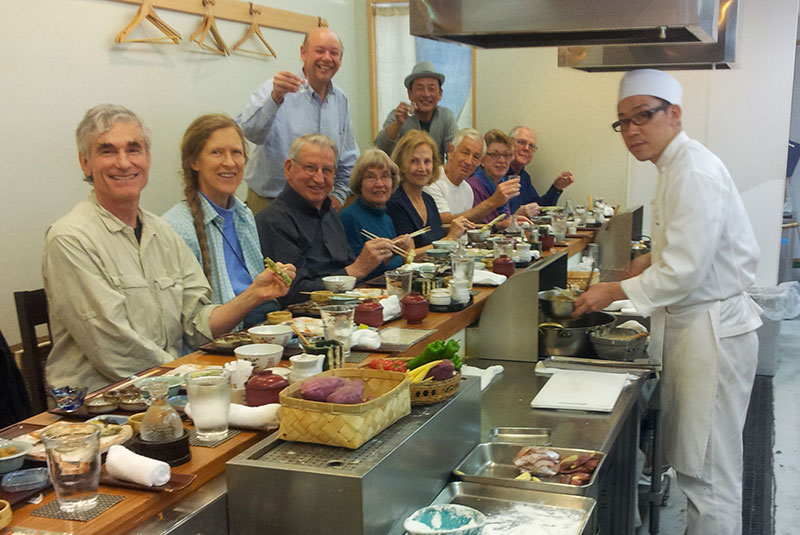
Even better, the joys of this meal have deepened over time. When we first visited his restaurant six years ago, Nishinaka-san was somewhat formal and reserved, anxious to satisfy his foreign guests. But as we have returned year after year, he has become much more relaxed. Now, since we are the only diners and he already thinks of us as friends, he feels free to converse with us as he concocts his culinary masterpieces, and an added delight of our visits has become talking about his training, daily life, and guiding philosophy as a tempura master. On our last visit, he took me aside and told me, with a big smile, that our visits have become the highlight of the year for him, and that he begins to look forward to our visit and to plan for it a month in advance.
For me, it is a joy beyond words—and the ultimate realization of my goal as a guide–to see our travelers communicate with him, and him with them, to see this intimate bridge of cultural connection being built right before my eyes. The result is a special communion that threads a certain magic throughout our trip; a larger group would miss this magic.
From Kyoto, our group moves to Shikoku, my wife’s home island, where the small size of our group enables another cultural epiphany. On this day, we visit a tiny fishing village, where we’re greeted by Tanaka-san, the gregarious fisherman who operates the local fish market and a simple four-table fish restaurant nearby. First he takes us to a stand where the day’s catch is laid out. He invites us to choose the two katsuo, or bonito, that we will have as the centerpiece of our lunch.
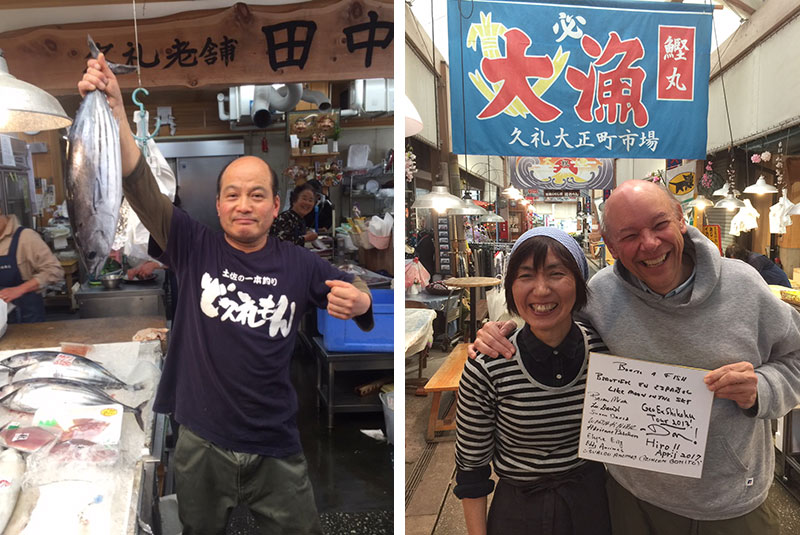
After we’ve chosen, he takes the fish and expertly fillets them, then leads us along a narrow path to an area behind his market where a metal barrel filled with straw is waiting. There he takes out a long-handled metal grilling basket, places one fresh filleted fish in this grill, and lights the straw in the barrel. Then he thrusts the fish into the leaping flames, holding it in just long enough to lightly sear the fillet on both sides. Then he places the second fillet in the grill and invites members of our group to do the searing.
After that we assemble in the tiny restaurant, again comfortably filling the space so that it becomes our private party, and his delightful wife, Setsuko-san, takes over, serving us locally made sake and a variety of sashimi fresh from the morning catch. After about 20 minutes, the star of the show arrives—platters of our sliced katsuo tataki, the lightly seared bonito that is a specialty of this region and is famed throughout Japan. With a religious reverence, we take slices of this delicacy and place them in our mouths, savoring the layers of flavor and texture, the seared surface perfectly complementing the soft middle of the sashimi, and giving each slice an extraordinary tenderness and succulence.
This is truly the best meal I have ever had. The first time we ate it as a group, we were all so moved that we asked Setsuko-san if we could write a haiku poem celebrating the dish. She happily brought us a square white cardboard shikishi, or “art board,” and we penned a haiku on the spot. She was so delighted that she promptly hung it on the wall of her restaurant. Now this has become a cherished tradition for our group, and at the end of each visit, we create a haiku to celebrate the best meal we have ever had.
Again, this extremely special experience is possible only because our group is so small that it has become almost an extension of the lovely couple’s family. In fact, two years ago, Setsuko-san shyly but proudly announced to our group that because of our visits, her daughter had decided to study for a year in the United States! Intercultural connection doesn’t get any better than that.
The third highlight our small group size makes possible occurs in Shikoku’s remote Iya Valley, where paved roads weren’t introduced until the 1950s. Wandering in the lush green folds of that valley in the 1970s, American author and Japan expert Alex Kerr fell in love with an atmospheric, abandoned, 300-year-old thatched-roof farmhouse. He bought it and restored it meticulously, and eventually opened it to travelers. Now groups of 10 or fewer can spend the night at the farmhouse, soaking in the atmosphere of old Japan; we purposefully limit our group size so that we can overnight here, and this stay is one of the soul-stirring treats of our trip.
We arrive in the late afternoon and exult in the view of the densely wooded hills, then enjoy a feast prepared and delivered by a local woman, who always delights in welcoming us. Then we savor the gleaming wooden floors, rice paper sliding doors, and rice paper lanterns of this exquisitely preserved treasure, before snuggling into the farmhouse’s thick futon comforters for the night. (Happily, Alex Kerr has added exquisite modern facilities too!)
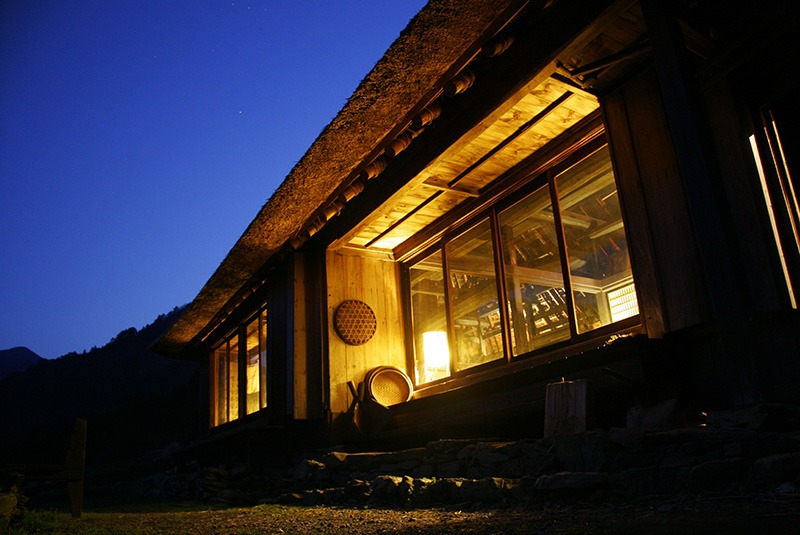
We awake to the breathtaking sight of pockets of mist rising up the slopes, catching like strands of cotton in the branches of the cedars and pines. We feel like we’re in heaven, or in an ancient sumi-e brush-and-ink painting. Our travelers invariably call this one of the most memorable nights of their lives, and we are able to stay here only because of our small group size.
To my mind, these three examples amply illustrate the advantages of small-group trips, and they exemplify why GeoEx is so devoted to sending small groups into the world. The intimate, profound encounters and experiences such groups make possible are priceless.
*****
With a handful of exceptions—and in stark contrast to most other travel companies—all of GeoEx’s journeys are for 12 travelers or fewer. Here are seven more trips that take advantage of the special opportunities and camaraderie that have so enriched my Japan journeys.
Mystical Ladakh: Marvel at masked cham dances and monastery celebrations at a local tsedup festival, immerse in morning chants with Buddhist monks at Thiksey Monastery, and meet with local Ladakhi artisans and experts on history and culture.
Essence of Bhutan: Ramble through remote villages and hidden valleys, stopping at venerable monasteries and rural markets, with opportunities to meet local villagers, artisans, and monks.
Morocco: From Casablanca to Marrakech: Sleep in a Bedouin-style camp in the Sahara, enjoy a private art collection and cooking class, savor intimate culinary feasts.
Botswana: The Miraculous Delta: See swimming elephants on safari in the Linyanti reserve, spot hippos and crocodiles in the wilds of restricted-access Seba Camp, and view wetland and savannah wildlife on outings by mokoro canoe in the remote Vumbura Concession.
Into Patagonia: Hike in Torres del Paine National Park, savoring views of jaw-dropping summits, and watching for condors and silver foxes; revel in remote Estancia Cristina, a wild, beautiful, and welcoming wilderness ranch.
These are just a few of the world-wandering, wonder-inducing small-group journeys we offer. May this sampling whet your imagination for extraordinary adventures to come!
Yours in abiding wanderlust,
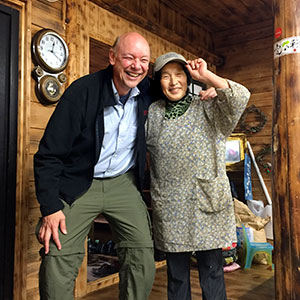
Don George
* * * * *
Do you have a question about one or more of our small-group journeys? Please share it below! And thank you, as always, for your comments, questions, and observations. They are truly inspiring and gratifying to read!
Bonjour Don, when are you planing the trip to Japan?
I had the pleasure of traveling with Don on this trip a couple of years ago. Here are a few photos from that amazing journey:
– Nishinaka-san, our wonderful tempura master in Nara. Written behind him: “I dedicate my life to my art.”
– The above-mentioned, haiku-inducing, bonito!
– View from one of the vine bridges on Shikoku island.
I want to travel


